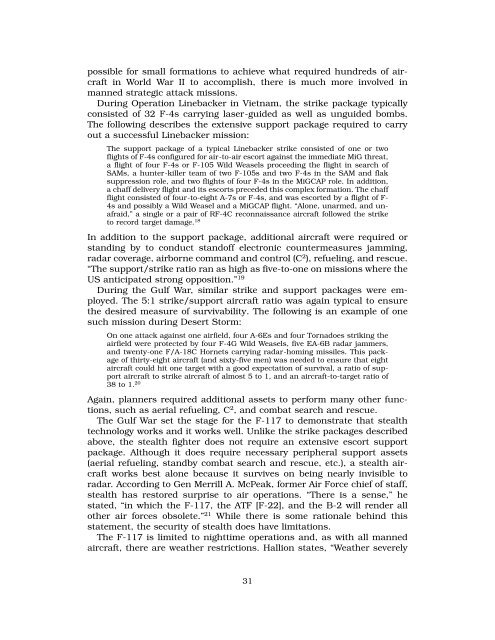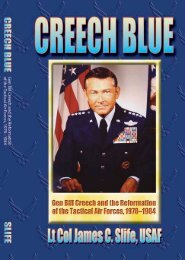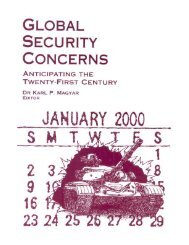Expendable Remotely Piloted Vehicles for Strategic Offensive ...
Expendable Remotely Piloted Vehicles for Strategic Offensive ...
Expendable Remotely Piloted Vehicles for Strategic Offensive ...
Create successful ePaper yourself
Turn your PDF publications into a flip-book with our unique Google optimized e-Paper software.
possible <strong>for</strong> small <strong>for</strong>mations to achieve what required hundreds of aircraftin World War II to accomplish, there is much more involved inmanned strategic attack missions.During Operation Linebacker in Vietnam, the strike package typicallyconsisted of 32 F-4s carrying laser-guided as well as unguided bombs.The following describes the extensive support package required to carryout a successful Linebacker mission:The support package of a typical Linebacker strike consisted of one or twoflights of F-4s configured <strong>for</strong> air-to-air escort against the immediate MiG threat,a flight of four F-4s or F-105 Wild Weasels proceeding the flight in search ofSAMs, a hunter-killer team of two F-105s and two F-4s in the SAM and flaksuppression role, and two flights of four F-4s in the MiGCAP role. In addition,a chaff delivery flight and its escorts preceded this complex <strong>for</strong>mation. The chaffflight consisted of four-to-eight A-7s or F-4s, and was escorted by a flight of F-4s and possibly a Wild Weasel and a MiGCAP flight. “Alone, unarmed, and unafraid,”a single or a pair of RF-4C reconnaissance aircraft followed the striketo record target damage. 18In addition to the support package, additional aircraft were required orstanding by to conduct standoff electronic countermeasures jamming,radar coverage, airborne command and control (C 2 ), refueling, and rescue.“The support/strike ratio ran as high as five-to-one on missions where theUS anticipated strong opposition.” 19During the Gulf War, similar strike and support packages were employed.The 5:1 strike/support aircraft ratio was again typical to ensurethe desired measure of survivability. The following is an example of onesuch mission during Desert Storm:On one attack against one airfield, four A-6Es and four Tornadoes striking theairfield were protected by four F-4G Wild Weasels, five EA-6B radar jammers,and twenty-one F/A-18C Hornets carrying radar-homing missiles. This packageof thirty-eight aircraft (and sixty-five men) was needed to ensure that eightaircraft could hit one target with a good expectation of survival, a ratio of supportaircraft to strike aircraft of almost 5 to 1, and an aircraft-to-target ratio of38 to 1. 20Again, planners required additional assets to per<strong>for</strong>m many other functions,such as aerial refueling, C 2 , and combat search and rescue.The Gulf War set the stage <strong>for</strong> the F-117 to demonstrate that stealthtechnology works and it works well. Unlike the strike packages describedabove, the stealth fighter does not require an extensive escort supportpackage. Although it does require necessary peripheral support assets(aerial refueling, standby combat search and rescue, etc.), a stealth aircraftworks best alone because it survives on being nearly invisible toradar. According to Gen Merrill A. McPeak, <strong>for</strong>mer Air Force chief of staff,stealth has restored surprise to air operations. “There is a sense,” hestated, “in which the F-117, the ATF [F-22], and the B-2 will render allother air <strong>for</strong>ces obsolete.” 21 While there is some rationale behind thisstatement, the security of stealth does have limitations.The F-117 is limited to nighttime operations and, as with all mannedaircraft, there are weather restrictions. Hallion states, “Weather severely31






